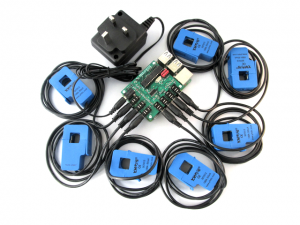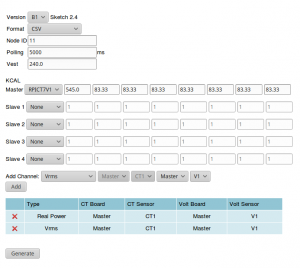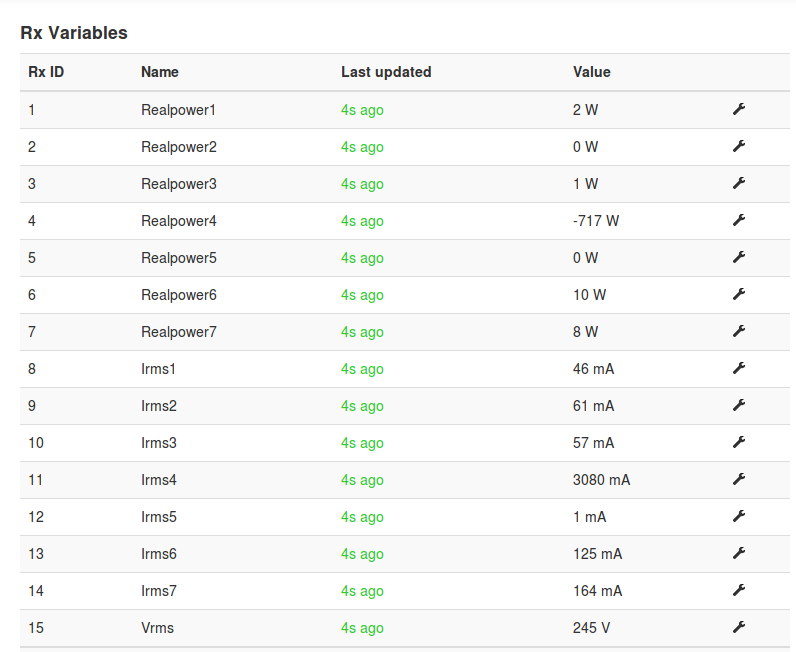RPICT7V1 Version 4

RPICT7V1 (This covers for hardware versions 4)
This page is for board specific information. More information can be found on the generic page for RPICT series.
The RPICT7V1 is the same unit as earlier version RPICT7V1_v2.0 but with top end instrumentation amplifiers. This can be considered as the Ferrari of the RPICT series.
- 7 AC current sensors.
- 1 AC Voltage sensor.
- Measure RMS Current and Voltage, Active power, Apparent Power, Power Factor.
- Fit on Raspberrypi 4 holes mounting pattern.
- AtMega328 Mcu (Arduino UNO)
- MCP3208 12bit ADC
- High precision Instrumentation Amplifier AD623.
- Supports both Current and Voltage output CT.
Compatibility
| Version | Compatible? |
|---|---|
| Raspberrypi 1 A | No |
| Raspberrypi 1 B+ | Yes |
| Raspberrypi 2 B | Yes |
| Raspberrypi 3 B | Yes |
| Raspberrypi 3 B+ | Yes |
| Raspberrypi 4 B | Yes |
- Asus Tinkerboard has been reported to work with RPICT units. Note we wont be able to provide support for the Tinkerboard.
Recommended Sensors

AC Current
Both current and voltage output are supported.
- Current Output CT
- SCT-013-000
- SCT-019
- SCT-006
- Voltage Output CT
- SCT-013-005
- SCT-013-010
- SCT-013-015
- SCT-013-020
- SCT-013-025
- SCT-013-030
- SCT-013-050
- SCT-013-060
Other CT sensor than the one listed here can be supported too. Contact us to enquire.
For Current output CT the RPICT board must have a burden resistor fitted.
For voltage output CT there is no need for a burden resistor. The pro for this is the ability for the user to be able to change CT using the same RPICT7V1 Version 4 unit. Only the calibration coefficient has to be modified in the configuration.
AC Voltage sensor
220V 240V & 110V
- UK: 77DB-06-09
- EU: 77DE-06-09
- US: 77DA-10-09
400V or more
- ZMPT101B
There are current development working on the ZMPT101B which has excellent measuring capability. Voltage up to 1000V can be measured. Contact us for more information.
Amplification Level
The new feature about RPICT7V1 Version 4 is the addition of instrumentation amplifiers AD623. This brings very sensitive and accurate method to measure physical values. Outstanding stability of the results has also been noticed.
Moreover the amplification level allows for more flexibility on the choice of the burden resistor. The scale is no longer depending on it. Hence improving on the linearity of the CT output for low current readings.
Read the following page to find out how resistors are calculated.
Amplification RPICT7V1 Version 4
Stacking Configuration
Version 4 can not be stacked at this stage. Contact us for enquiries on stacking development.
Software Configuration
Using a serial line terminal program one can configure the following:
- Polling interval - Output format (csv or emonhub) - Calibration values (Voltage and Current) - Voltage/current combinations for real power computation. - Output channels
The documentation for serial configuration can be found on this page.
Over Serial Configuration - Sketch 3.0
 The board can be configured with the online configurator.
The board can be configured with the online configurator.
Files
Default Sketch
Emoncms Config (Emonhub)
Make sure you read this first.
For default configuration. Used as single board only (not stacked).
[[11]]
nodename = my_RPICT7V1
hardware = RPICT7V1
[[[rx]]]
names = RP1, RP2, RP3, RP4, RP5, RP6, RP7, Irms1, Irms2, Irms3, Irms4, Irms5, Irms6, Irms7, Vrms
datacode = 0
scales = 1,1,1,1,1,1,1,1,1,1,1,1,1,1,1
units =W,W,W,W,W,W,W,mA,mA,mA,mA,mA,mA,mA,V
Related Pages
Howto setup Raspbian for serial read
